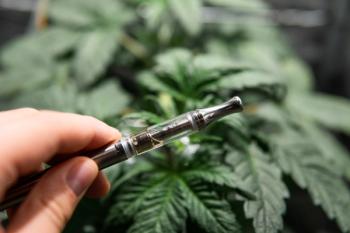
Cannabis Science and Technology
- May 2022
- Volume 5
- Issue 4
- Pages: 36-41
Fundamentals of Supercritical Fluid Extraction: Using Carbon Dioxide as an Environmentally Friendly Solvent for Extraction of Cannabis
This article describes the nature of supercritical fluids and how they can be used in the cannabis industry.
With increasing legalization and demand for medical and recreational cannabis and hemp products, preparation of pure oil concentrates is becoming widespread. While liquid solvents can be used for production of concentrates, traditional solvents such as alcohols or propane gas pose hazards because of their flammable nature. Further, residual solvent can remain in the end product. Supercritical fluid extraction (SFE), using carbon dioxide (CO2), is emerging as a method of choice within the cannabis industry for preparation of pure products. Although CO2 is typically thought of as a gas, or a solid like dry ice, it can be transformed into a useful and safe extraction solvent through the application of mild pressure and temperature increases just above ambient conditions. Using commercially available equipment, SFE represents an efficient and safe extraction alternative to conventional solvent extraction yielding cannabis and hemp oils with no solvent residues. This article describes the nature of supercritical fluids and how they can be used in the cannabis industry. A schematic diagram of a one pass extraction system is described.
As legalization and demand for medical and recreational cannabis and hemp products increases, the extraction of leaf and bud for preparation of concentrated oils is becoming commonplace. While liquid solvent-based methods are available for the generation of concentrates, traditional liquid solvents such as alcohol or propane gas pose hazards because of their flammable nature. Supercritical fluid extraction (SFE), using carbon dioxide (CO2), is emerging as a favored method within the cannabis industry. Although CO2 is typically thought of as a gas, it can be transformed into a useful and safe extraction solvent through an increase of pressure and temperature. SFE represents a powerful extraction alternative to conventional solvent-based methods yielding cannabis oils with no solvent residue. Furthermore, the use of SFE avoids many potentially serious hazards to personnel while yielding a purer product to the end user.
What is a Supercritical Fluid?
The most familiar of three states of matter is typically seen in water—ice as solid, water as liquid, and gas or vapor. Other chemical compounds such as carbon dioxide can also exist in three states. For carbon dioxide, we are familiar with the invisible gas which we exhale, and as a byproduct of fermentation and combustion. The solid, known as dry ice, is used for keeping materials cold, while liquid CO2 must be held under pressure to remain in the liquid state. But there is another less familiar state of matter known as a supercritical fluid (SCF).
While there is nothing “super” or even “critical” about such fluids as the name might imply, its unique capabilities under specific process conditions of temperature and pressure make it useful in extraction applications. SCF offers multiple advantages when used for extraction. This is because an SCF has intermediate properties between more familiar states of matter, and it can diffuse through solids like a low-density gas, but dissolve materials similar to liquid solvents. In addition, close to the critical point, small changes in pressure or temperature result in significant changes in density, permitting many properties of a supercritical fluid to be altered or “tuned.” SCF CO2 is also considered a “green” solvent because of its low environmental impact as it is not considered a volatile organic compound (VOC). Many other substances such as water and small molecules like organic hydrocarbons (propane, butane) can also exist in a critical state though under much different temperature and pressure conditions. However, these fluids do not offer the same advantages as CO2 and their use is generally more restricted.
The description of a supercritical fluid, sometimes referred to as a critical fluid, is any substance existing above its critical point (CP) of temperature and pressure. This concept is best understood by inspection of the phase diagram in Figure 1. There are two prominent intersections in the phase diagram. The first is the Triple Point (Tr), a unique combination of temperature and pressure of 5.2 atm (76.5 psi) and 56.4 ºC. Here CO2 can simultaneously coexist in three phases in equilibrium as a solid, liquid, and gas. The second notable intersection and of importance for this discussion is the critical point at the end of the gas-liquid distillation or equilibrium curve. The CP is the highest temperature and pressure at which a gas and liquid can coexist. Beyond this is the critical region where no change in temperature or pressure will liquefy the gas. Within this region, due to its compressibility, large changes of fluid density can be achieved with variations in pressure and temperature.
Since there is no phase change or liquid-gas phase boundary (such as along the distillation curve) there is no surface tension. This lack of surface tension and low viscosity compared to liquid solvents means that an SCF can readily diffuse into a matrix, enhancing rapid extractions. By retaining gas-like diffusivity it easily penetrates dry media to rapidly dissolve solutes (substance to be extracted) while maintaining near liquid-like solvation behavior. As efficient extraction is diffusion-based, it dissolves the solute, then diffuses from the matrix while retaining the solute as with a conventional liquid solvent. By comparison, an extraction using an organic liquid may take several hours, whereas supercritical fluid extraction can be completed in 10-60 min (1) depending on the substrate extracted.
Although several low molecular weight gases can be used for SFE, CO2 is the most attractive because it combines the solvation power of liquid solvents such as hydrocarbon solvents or alcohols with safety, nontoxicity, and nonflammability. All this can be achieved under mild process conditions, minimizing potential product thermal degradation. Furthermore, because of changes in extraction temperature and pressure process conditions, its solvation characteristics can be modified or “tuned.” Carbon dioxide is the most common supercritical fluid because of its desirable properties.
While many small molecules (especially gases) have their own unique critical properties, most are not as useful as carbon dioxide. This is because the critical property of CO2 falls in a range where low temperature and pressure process conditions make it attractive, especially for heat labile materials. These properties are listed in Table I. Whereas, normal liquid solvents have fixed densities of around 1 (as with water) a CF has variable densities from about 0.3 to 0.9 grams/cm3. This changeable density affects its ability to dissolve, hence recover, valuable extractants such as cannabis oils. Table II shows a comparison of properties among gases, liquids, and supercritical fluids.
Supercritical Fluid Extraction
Supercritical fluid extraction (SFE) is the process of separating one component (the extractant or solute) from another (the matrix) using a supercritical fluid as solvent. Extraction typically occurs from a solid matrix, but can also take place from liquids especially for fractionation. SFE is often used as a sample preparation step for analytical purposes, but is easily scaled to extract large quantities of a desired material.
Typical extraction processes occur on a continuous basis as fresh SCF is recirculated through an extraction vessel. Once the SCF is laden with solute, it flows into a subcritical pressure vessel or through a pressure letdown valve for product collection. Reduction of pressure from the critical state to a gas at ambient pressure decreases solvation and the solute (oil) drops out and is then recovered. The solute, now at atmospheric pressure, will readily lose any residual CO2 leaving no contaminants.
The SCF is then recompressed for recycle back to the extraction vessel after pumping up to the desired process temperature and pressure. A continuous flow is thereby maintained. If an SCF expands from a pressure letdown valve, heat must be added to the valve as the rapid expansion, known as the Joule-Thomson effect, can cause the valve to freeze and plug. The schematic in Figure 2 shows a simple one pass extraction system where SCF CO2 is vented to atmospheric pressure and the solute is collected at the end of a letdown valve. The shaded area represents a modifier extension which may be eliminated if cosolvents are not used.
Carbon dioxide’s wide availability, low-cost, and food grade status make it ideal as an extraction solvent, and the most widely used SCF extractant. Separation of extraction products are easily achieved on reduction of pressure from the critical state as products are not soluble in gaseous CO2. Supercritical fluid CO2 is suitable as a substitute for organic solvents and is currently used in a wide range of industrial and laboratory processes particularly where heat sensitive materials are extracted. Supercritical fluids have long been used in the food industry for the extraction of a variety of materials such as oils from hops, caffeine from coffee beans and teas, fractionation of edible fats and oils such as wheat germ oil, green coffee oil, rice bran oil, or palm oil, along with many other valuable food-related products (1). Many other vegetable oils, essential oils, fatty acids, phospholipids, and bioactive compounds are also processed using SCF (2).
Property Modifiers
Supercritical carbon dioxide is considered a nonpolar solvent (similar to nonpolar hydrocarbons such as propane, butane, and hexane, for example). While CO2 readily solubilizes oil type compounds such as cannabis oils, it does have an affinity for polar molecules (more water soluble) especially at higher pressures, so it is capable of dissolving materials of this nature. In some cases, to extract polar molecules more efficiently, a cosolvent such as ethanol, known as a modifier, may be added in small percentage to the CO2 process stream enhancing the extractability. Extractions using modifiers in supercritical carbon dioxide will require slightly altered temperature and pressure parameters to maintain conditions above the CP. However, as the primary constituents of cannabis are soluble in hydrocarbon (nonpolar) solvents, they will readily dissolve in pure SCF CO2.
Commercial Equipment
Many companies have developed extraction systems for use for supercritical extraction (3,4). With the advent of lab-scale and pilot-scale technology in this industry, commercial equipment is readily available. Units can range in size from benchtop units of a few milliliters in size to large process scale equipment capable of extracting kilogram quantities of material (5). Such equipment uses SCF CO2 where materials to be extracted are treated in large, pressurized vessels of several thousand liters. Product is then recovered by pressure let-down through a valve or a collection chamber where pressure is reduced to atmospheric conditions.
Summary
The use of supercritical fluid CO2 for the extraction of cannabis oils provides many advantages compared to the use of conventional solvents because of its nontoxic and nonflammable nature. Its availability, low-cost and food-grade status make it an ideal solvent. Also, because only mild conditions are required for processes, (temperature 31.2 ºC and pressure 1078 psi), no product degradation is likely to occur, and products remain free from residual solvents. Extraction equipment is readily available for pilot-scale and commercial extraction operations making SFE the method of choice for cannabis extraction.
References
- O.N. Ciftci, J. Food Process Technol. 3, e105 doi:10.4172/2157-7110.1000e105 (2012).
- S. Rahoma, S. Mohameda, and G. Ali Mansoorib, “The Use of Supercritical Fluid Extraction Technology in Food Processing,” a School of Chemical Engineering, The State University of Campinas-Unicamp, C.P.6066, Campinas-SP, 13083-970, Brazil, b Chemical Engineering Department, The University of Illinois-Chicago
https://www.chemtronlabs.com/products/supercritical-fluid-extraction-system.html https://www.supercriticalfluids.com/products/custom-solutions/supercritical-carbon-dioxide-reaction-extraction-systems/ - Eden Labs LLC, Precision Extraction Solutions, Supercritical Fluid Technologies, Inc.,
About the Author
After 25 years as a research chemist for 3M Company in St. Paul, Minnesota, Craig A. Perman moved to Colorado. While at 3M he authored more than 20 patents in a diversity of areas including supercritical fluid processing, new molecule synthesis, and processes for the preparation of high strength, low-density polymer foams. He is currently president of Aqua Technica Inc., working in the area of solid phase extraction products for environmental water analysis, and technical writing. He has authored numerous publications and articles and has presented nationally and internationally at many conferences. Direct correspondence to:
How to Cite This Article:
C. Perman, Cannabis Science and Technology® Vol. 5(4), 36-41 (2022).
Articles in this issue
over 3 years ago
Beer’s Law, Part III: Demystifying the Absorptivityover 3 years ago
LED Lights Lead the Way in Cannabis Cultivationover 3 years ago
Taking a Measure of Evolving Extraction TechnologyNewsletter
Unlock the latest breakthroughs in cannabis science—subscribe now to get expert insights, research, and industry updates delivered to your inbox.


